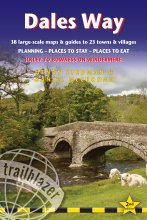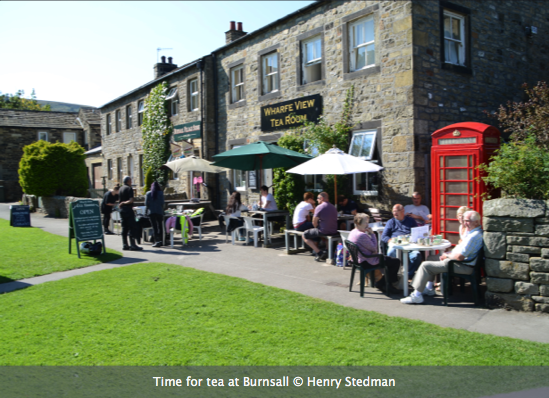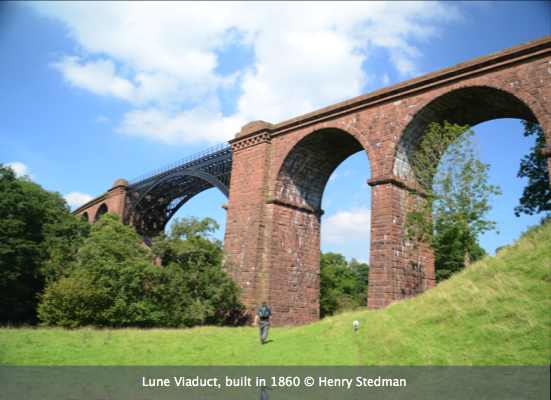'Fantastically detailed and well-presented.'
— Backpack magazine

Dales Way: Ilkley to Bowness-on-Windermere
Excerpt:
Practical information for the walker
Contents | Introduction | History | Practical information for the walker | Sample route guide: Barden Bridge to Burnsall | Sample Trail Profile & Overview Map
How difficult is the Dales Way?
In all honesty, it’s not. Sure, there are a few steepish ascents that will have you blowing hard, and your knees might complain during some of the longer descents too. But overall the Dales Way is short, fairly level, well signposted, with plenty of towns and villages en route should you need to buy provisions or seek help. With civilisation never far away your chances of losing your way, or suffering from hypothermia or heatstroke are slender; indeed, the biggest danger along the whole path is being squashed by a car on the busy B6255 before Bolton Abbey. Nevertheless, it would be foolish to take the Dales Way too lightly. Like any long-distance trail, it deserves respect. Most importantly, perhaps, you should read up about each stage of the trail beforehand and prepare properly for it, for there are a couple of stages where shops, cafés and accommodation are pretty much non-existent, so you need to plan your day sensibly, maybe by preparing a packed lunch before you set off and taking plenty of water.
You should also read the section on trail safety (pp55-8).

How long do you need?
Most people take about a week to complete the Dales Way. It can be done much more quickly and if you feel the need, by all means do it in four days or fewer. Just don’t bore me in the pub with tales of your exploits. If, on the other hand, you prefer to take 6-8 days or more on the trail, taking the time to drink in the magnificent scenery, while pausing here and there to smell the flowers or gaze at otters frolicking in a stream, then I believe you’re walking the Dales Way as it’s meant to be walked. And in this case you can bore me in the pub all you want about the marvels that you’ve seen. Because I love otters. Especially ones that frolic.
When to go
SEASONS
Britain is a notoriously wet country and the Yorkshire Dales and Lake District are two of the wettest parts of it. With the Dales Way taking less than a week, it is possible to walk the entire route without experiencing even a drop of rain. But you’d be lucky. That said, with 150 wet days per annum in the Yorkshire Dales, you’d be even unluckier to have wet weather every day of your trek.
The main trekking season in the Dales runs from Easter to when the clocks change at the end of October. You can walk outside of this season, of course, but the shorter days, the lack of fellow trekkers and inclement weather mean that it’s a trickier undertaking – and if there’s snow about it’s also considerably more dangerous. Furthermore, you may also find that many of the B&Bs and other amenities may be closed for the season, particularly in rural areas.
Spring
A beautiful spring day is one of the true, unfettered joys of living in Britain. With birds singing, flowers budding and lambs gambolling, it’s just wonderful. However, spring also happens to be one of the wettest times of year, so be prepared for the worst and bring your rain gear; this will improve your chances of not being rained upon no end. Aside from Easter, you should find the trail to be very quiet – allowing you to enjoy the delights of the season undisturbed.
Summer
The main disadvantage with summer is that it can get a little too busy in the Dales and the Lake District. But arrive outside of the main school summer holidays and it shouldn’t be too bad. Other than this, there are no negatives to trekking in summer. The weather is usually better (though bring your waterproofs nevertheless – remember, it does rain for 150 days a year in the Dales, and some of those have to be in summer!), the days are at their longest and all the campsites, cafés and other facilities will be open. Furthermore, if you’re in need of company you won’t be short of trekking companions on the Dales Way – which could be useful if you’re far from civilisation and need help. Remember to book your accommodation in advance if trekking in this season, particularly if staying in B&Bs.
Autumn
September and early October are lovely times to walk. The relative ‘chaos’ of the summer months have abated to be replaced by a more tranquil, sedate scene. The shops, B&Bs and pubs should all still be open, as should the campsites, and I find that their owners are more relaxed and friendly, presumably because they’ve survived and thrived in the main trekking season, and thus can afford to take their foot off the gas and relax a little. The weather is usually pretty settled at this time, though do follow the forecasts closely as there are the occasional storms at this time. By the time mid October rolls around the days are getting rather short and the weather may well be getting wilder – time for most trekkers to hang up their trekking gear for another year.
Winter
Happen upon one of those clear, crisp winter days when the wind is becalmed and the sun is shining and you’re in for a treat – and if there’s snow on the ground it can feel like you’re walking in the middle of a Christmas card. That said, those days can be few and far between. What’s more, most of the accommodation outside of the larger towns will be closed and many of the pubs, shops and cafés operate reduced opening hours. It is also, of course, more dangerous to be out on the fells at this time – and given the record of flooding in the region over the past few years, it’s not particularly sensible to be walking by the riverside all day – which pretty much rules out all of the Dales Way.

Dales Way: Ilkley to Bowness-on-Windermere
Excerpts:
- Contents
- Introduction
- History
- Practical information for the walker
- Sample route guide: Barden Bridge to Burnsall
- Sample Trail Profile & Overview Map
Price: £12.99 buy online now…
Latest tweets